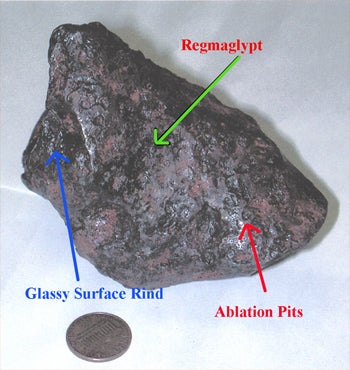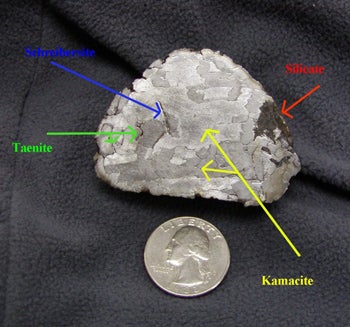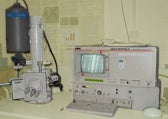|
| |
|
|
|
|
|
|
|
|
|
| |
|
|
 |
|
|
|
 Fig. 2 Sample after cutting, polishing, and acid etching Fig. 2 Sample after cutting, polishing, and acid etching |
|
|
| |
|
|
Fig. 1 Outside surface before preparation |
|
|
|
|
|
|
|
|
|
|
|
|
|
|
|
Abstract:
...In early 2004 the Marshall University Geology Department obtained a sample of a meteorite found by Mr. Skip Spencer of Charleston, WV. It was found near Blacksburg, VA. The purpose of this study was to confirm that the sample was a meteorite and to classify it as to its type. The sample was highly magnetic, had a black ‘fusion crust’, and showed the presence at the surface of ‘regmaglypts” (thumbprint shaped atmospheric burn marks).
The meteorite was cut in two with a rock-saw and then polished to a high sheen with 1u alumina paste. The polished surfaces were etched using a solution of ethyl alcohol (90%) and nitric acid (10%). The etched samples were then studied with a polarizing microscope and with a Scanning Electron Microscope (SEM-EDS).
Based on preliminary chemical, mineralogical, and structural studies, this meteorite can be classified as a coarse to medium Octahedrite, type IAB. Minerals identified are the two Fe-Ni minerals kamacite (Ni,< 6%) and taenite (Ni, > 25%), schreibersite ((Fe, Ni)3 P), and a silicate mineral (probably olivine ((Mg, Fe)2 Si O4 ). Etching clearly showed the Widmanstätten pattern, formed by the intergrowth of kamacite and taenite lamellae. Also seen at places are Neumann Lines, fine sets of parallel lines created within kamacite due to the development of twinning.
Further analyses of trace elements (Ge, Ga, Ir) is being conducted to determine the exact classification and also to determine whether this sample is related to an octahedrite (Dungannon) previously reported from Virginia.
|
|
|
|
|
|
|
|
|
|
|
|
|
| . |
|
|
|
|
|
|
|
|
|
|
|
|
|
|
|
|
| |
|
|
Fig. 3a Kamacite under SEM Magnified x 100 |
|
|
| |
|
|
|
|
|
|
|
|
Objective:
This study was conducted to determine if this sample is a meteorite. Finding that it is a meteorite an attempt will be made to identify the minerals present and classify the meteorite into its chemical and structural classes.
|
|
|
| |
|
|
|
|
|
| |
|
|
|
|
|
| |
|
|
Fig. 3b Kamacite SEM X-ray spectrum analysis (Iron - Nickel) |
|
|
|
|
|
|
|
|
|
|
. |
|
|
|
|
|
|
|
|
|
|
| |
|
|
|
|
|
| |
Fig. 4 Neumann Lines under S.E.M. X 500 appear as closely spaced parallel groves. |
|
| |
|
|
| |
Materials and Methods: |
|
| |
|
|
|
| |
Meteorite sample collected by ‘Skip’ Spencer (retired geologist)
Rock saw Lapidary polishing wheel
120 to 800 grit paper & alumina polishing paste (1 u)
Ethyl alcohol, Nitric acid, Hydrochloric acid |
Standard solutions of Ni, Co, Ga, Ge, Cu, and Cr
Scanning Electron Microscope (SEM - EDS)
Inductively Coupled Plasma Spectrometer (ICP-AES)
Petrographic Microscope
|
|
| |
|
|
| |
o The meteorite was first tested for magnetic strength as a general test.
o The surface was then observed for atmospheric ablation characteristics
with a petrographic microscope.
o The meteorite was then cut on a rock saw. This presented great difficulty
due to the strongly crystallized metal and the frictional heat of sawing
causing expansion pinching of the blade.
o The cut sample was polished using grit paper on a lapidary wheel; the final
polishing was done with the alumina paste. The resulting surface had
mirror quality reflectance.
o The polished surface was etched for approximately thirty minutes with a
mixture of ethyl alcohol (90%) and nitric acid (10%).
o Once etched, the sample was prepared for the S.E.M. by immersion in
alcohol for dehydration, and then the alcohol volatized at 150o C. The
sample was placed directly into the S.E.M. with landmarks referenced
with graphite paint. A piece of 100% copper was used as the EDS
standard.
o For chemical analysis, a small slice of the meteorite was dissolved in acid.
o The ‘stock’ solution thus obtained was analyzed for Ni, Co, Ge, Ga, Cu,
and Cr by the ICP-AES. ‘Standard Addition’ method was used to avoid
matrix effects. o The remaining part of the meteorite has been preserved using a coating of
paraffin wax and stored with silica gel. |
|
| |
|
|
| . |
| |
|
|
|
|
|
| |
|
|
|
|
|
| |
|
|
Fig. 5a Taenite Composition under SEM X-ray analysis.
Note that lighter areas mark higher concentration. |
|
|
| |
|
|
|
|
|
| |
|
|
Results:
1. Strong magnetic response
2. Atmospheric ablation marks and regmaglypts (Fig. 1)
3. Glassy rind (Fig. 1)
4. Metallic core (95%) composed of iron and nickel (Fig. 2)
5. Minerals identified:
| Kamacite |
Fe (93-96%) Ni (4-7%) |
iron rich |
(Fig. 3 A,B) |
| Taenite |
Fe(60-80%) Ni (20-40%) |
nickel rich |
(Fig. 5 A,B,C) |
| Schreibersite |
Fe (55%) Ni (14%) P (31%) |
accessory |
(Fig. 6 A,B) |
| Unidentified Silicate |
Mg, Si, P, S |
silicate |
(Fig. 7) |
| Troilite |
Fe S |
|
|
| Other small minerals embedded in Taenite and Schreibersite. |
6. Structures seen:
Widmanstätten pattern (Very coarse) (Fig. 2)
Neumann Lines (Fig. 4)
7. Chemical analysis:
| Ni (mg/g) |
Co (mg/g) |
Ga (u g/g) |
Ge (u g/g) |
Cu (u g/g) |
Cr (u g/g) |
| 67.3 |
6.3 |
168 |
293 |
123 |
5.3 |
|
|
|
| |
|
|
|
|
|
| |
|
|
 Fig. 5b Taenite Analysis
Fig. 5b Taenite Analysis
Note the significantly higher nickel. |
 |
|
|
| |
|
|
|
|
|
|
Fig. 5c Taenite S.E.M. X 350
Note the scale bar’s size.
The light colored areas are Schreibersite inclusions. |
|
|
| |
|
|
|
|
|
|
|
|
|
| |
| |
|
|
|
|
|
|
|
|
|
| |
|
|
|
|
|
| |
|
|
Fig. 6a Schreibersite band: S.E.M. X 200 |
|
|
| |
|
|
|
|
|
| |
|
|
Discussion:
1. The sample is a meteorite collected near Blacksburg, Va.
2. The magnetic strength separates this sample from slag material that
may have similar appearance.
3. The presence of regmaglypts (thumb-shaped indentations caused by
melting on atmospheric entry) along with the smaller ablation pits,
demonstrate that this sample is extra-terrestrial.
4. The glass rind on the outside surface also points to fusion during
atmospheric entry. This rind also prevented weathering.
5. The freshness of the iron and nickel, seen on the inside, also points to
a non-terrestrial origin. It is very rare to find such un-oxidized
terrestrial material.
6. The Widmanstätten pattern, which is a pattern produced between the
kamacite and taenite interface, confirms this is a meteorite.
Widmanstätten patterns develop in a zero-G environment and on very
slow cooling.
7. The presence of Neumann Lines, which appear as fine parallel lines
running in (up to) six directions, indicates impact with another body.
These lines are caused by twinning due to post-consolidation
compression.
8. The high Fe-Ni constituents identify this as an Iron meteorite.
9. The band-width of the kamacite within the Widmanstätten pattern
(average > 2 mm), and the content of Ni around 6.7%, indicates that
this is a coarse octahedrite.
10. The Ga-Ni and Ge-Ni concentrations, when compared to other
reported octahedrite values, points to the fact that this is a IAB type
iron. (Fig. 8) The Ga content is rather high, but high Ga values
are known in some octahedrites.
11. Schreibersite, and minor amounts of silicate minerals, are known to
occur in octahedrites. |
|
|
| |
|
|
|
|
|
| |
|
|
|
|
|
| |
|
|
Fig. 6b Schreibersite analysis
Note the presence of phosphorous. |
|
|
| |
|
|
|
|
|
|
|
|
|
| |
|
|
|
|
|
|
|
|
|
| |
|
|
|
|
|
|
|
|
|
| |
|
|
|
|
|
| |
|
|
Fig. 7 Silicate under SEM X 100
Note texture. |
|
|
| |
|
|
|
|
|
| |
|
|
Conclusions:
1. This sample is certainly a meteorite.
2. The Widmanstätten band-width, and the Ni, Ga, and Ge contents, all
classify this as an IAB octahedrite.
3. The chemical composition of this meteorite is markedly different from
the only other iron meteorite (Dungannon) found in Virginia
| |
Ni (mg/g) |
Co (mg/g) |
Ga (u g/g) |
Ge (u g/g) |
Cu (u g/g) |
Cr u g/g) |
| This sample |
67.3 |
6.3 |
168 |
293 |
123 |
5.3 |
| Dungannon |
69.5 |
4.72 |
78.8 |
332 |
153 |
27 |
4. Although the analytical method (ICP) used for this study is somewhat
semi-quantitative, there is a strong chemical indication that this
meteorite found near Blacksburg is distinctly different from the
Dungannon meteorite.
5. A strong case can be made that this is a previously unreported meteorite
find.
6. Further work will involve chemical analysis by a better quantitative
technique, and a closer control on the exact location and date of
collection.
Final Classification: Iron Coarse Octahedrite Type 1AB |
|
|
| |
|
|
|
|
|
|
|
|
|
| |
|
|
|
|
|
|
|
|
|
| |
|
|
|
|
|
|
|
|
|
| |
|
|
References
New England Meteoritical Services;
http://www.meteorlab.com/
Weir, David. Meteorite Information;
www.geocities.com/CapeCanaveral/9278/menu2.htm
Darling, David. Classification of Iron Meteorites;
www.daviddarling.info/encyclopedia/I/iron_meteorite.html
McDonough, W.F. Comp. Model for the Earth’s Core. Treatise on Geochemistry, Vol. 2, p.547-568, 2003 |
|
|
|
Acknowledgments
‘Skip; Spencer (Retired Geologist) Who kindly supplied the original specimen.
Dr. Aley El-Shazly (MU Geology) For help with analyses.
Dr. Mike Norton (MU Chemistry) Standars for analysis.
|
|
|
| |
|
|
| |
|
|
| |
|
|
|
|
|
|
|
|
|
| |
|
|

SEM instrumentation page
Back to Example Projects |
| |
|

